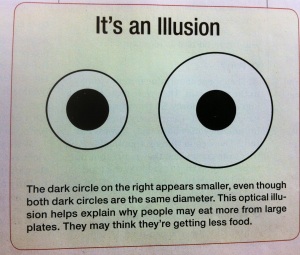The Center for Science in the Public Interest’s article featuring the wisdom from the research of Professor Brian Wansink, Cornell University, offers the cliff hanger for this week. Practical information for you!
The price of food: does it influence how much people buy? The answer is not simple. How much you buy obviously depends on how much money you have. Being below the poverty line, you have to buy the smaller items because you are budgeted, according to Wansink. “… if you’re above the poverty line, you can afford larger items. That’s where you get the Costco or Sam’s Club effect. You buy large quantities because you’re saving money.”, says Wansink. The Professor wrote a book called “Mindless Eating”. In it he speaks to studies that show that when items like juice boxes, granola bars, small bags of chips, etc. are individually packaged, you end up eating them more frequently: seven times per week vs. four. BUT, “if you buy a larger package of cereal or ground beef or pasta or pretzels, you eat more every time you open it.” – Wansink. The practical tip for portion/calorie control is to NOT avoid big packages. Divide the big packages into smaller packages and to put them somewhere that you don’t see them all the time/can store them/can’t easily get to them. If you are buying small packages, put them away for the same reasons. Out of sight = out of mind = less chance of over eating!
Another idea for healthy snacking comes from this study at Cornell. 200 kids were given either all-they-could-eat chips OR a combination of cut-up vegetables and round Babybel cheeses while they watched TV. Kids given the chips ate 620 calories’ worth, but kids given the cheese/vegetables ate only 170 calories’ worth. In overweight kids the difference was even more pronounced: they ate more chips than the others. The reasoning is quite simple. Cheese/vegetables take longer to chew. The combination was more satisfying because it’s fun to eat and there’s more variety in creamy cheese and crunchy vegetables. The study was done on women, and the results were similar. Wansink has no data (yet) for men, but hypothesizes that it will be also similar. The obvious practical tip: serve crunchy vegetables with low fat creamy dip!
Trigger Foods (simple psychology!)… Another study at the buffet indicated that the first food that people saw influenced what they took even if they didn’t take that food. If they saw a bowl of fruit first, they were more likely to take more fruit than eggs and bacon. If they saw eggs and bacon first, they took more of that than fruit. AT HOME: Make sure that the first food you see and serve is the healthiest food on the table. Serve the vegetables/fruit first!
What makes people happy with fewer calories? The Cornell researchers again checked this out by giving folks snacks to find out how much eaten would cause them to be satisfied. They found that once people swallow something they do not have much memory of how much they ate. If you are served and eat something tasty in a large or a small portion, 15 minutes after you ate it, you remember that it was yummy, but you do not remember how many bites you took. So with cravings, take a small bite/amount of something that you crave, wait 10 minutes, and your craving will have been satisfied. If you are at risk of bingeing because there is more of the craved food right in front of you, eat that small amount, and go to the restroom, walk around the block, bring your laundry basket upstairs and put away 10 min of laundry, write an email, etc. The distraction will save you from eating more, and you will have satisfied your craving. This does not work when a person is truly hungry. Often when we crave, it is not related to hunger!
Here’s a visual to leave you with re: your plates!
Have a delightful weekend, and thank a Veteran! Coming next week: more tips for you.

